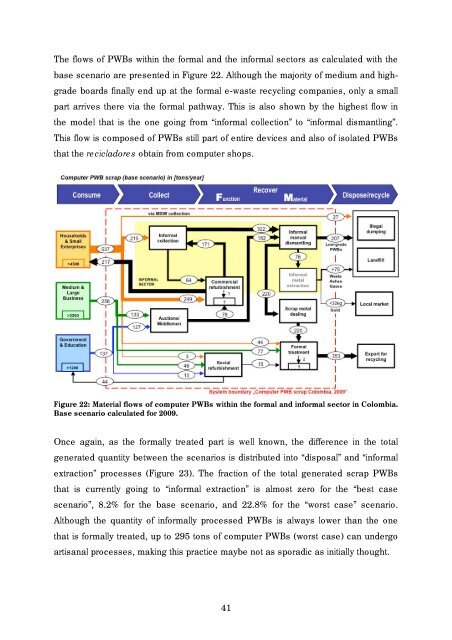10 07 29 Master thesis Juliana Leon - e-Waste. This guide
10 07 29 Master thesis Juliana Leon - e-Waste. This guide
10 07 29 Master thesis Juliana Leon - e-Waste. This guide
Create successful ePaper yourself
Turn your PDF publications into a flip-book with our unique Google optimized e-Paper software.
The flows of PWBs within the formal and the informal sectors as calculated with the<br />
base scenario are presented in Figure 22. Although the majority of medium and highgrade<br />
boards finally end up at the formal e-waste recycling companies, only a small<br />
part arrives there via the formal pathway. <strong>This</strong> is also shown by the highest flow in<br />
the model that is the one going from “informal collection” to “informal dismantling”.<br />
<strong>This</strong> flow is composed of PWBs still part of entire devices and also of isolated PWBs<br />
that the recicladores obtain from computer shops.<br />
Figure 22: Material flows of computer PWBs within the formal and informal sector in Colombia.<br />
Base scenario calculated for 2009.<br />
Once again, as the formally treated part is well known, the difference in the total<br />
generated quantity between the scenarios is distributed into “disposal” and “informal<br />
extraction” processes (Figure 23). The fraction of the total generated scrap PWBs<br />
that is currently going to “informal extraction” is almost zero for the “best case<br />
scenario”, 8.2% for the base scenario, and 22.8% for the “worst case” scenario.<br />
Although the quantity of informally processed PWBs is always lower than the one<br />
that is formally treated, up to <strong>29</strong>5 tons of computer PWBs (worst case) can undergo<br />
artisanal processes, making this practice maybe not as sporadic as initially thought.<br />
41
















